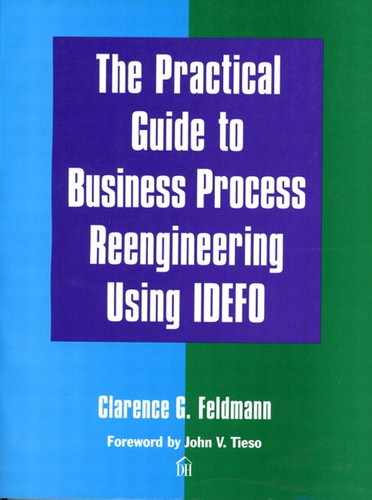Preface
For many years, there has been a call for a comprehensive book on the IDEFO method and its use in BPR. This book, written in answer to that call, is designed to introduce the method, its usage, and the benefits that can be achieved. It is also written to serve as a “do’s and don’ts” document to identify the ways the method has been misused in the past and to specify ways to correct these misuses.
This book presents essential information about the IDEFO method—its definition, basic rules of usage (including the standard language syntax and semantics as contained in the Federal Standard)—and lessons learned from many years of application in the real world. The examples depict actual commercial client and government agency models, from which names and proprietary information have been removed.
Who Should Read This Book
The material presented in this book is suitable for three categories of IDEFO users:
• people who wish to explore the concepts and the application potential of IDEFO for enterprise reengineering
• people who wish to determine how IDEFO might be helpful to them in their systems analysis efforts
• people who have been introduced to IDEFO concepts, and who wish to understand the theory behind the concepts so that they can use the method more effectively
The Department of Defense (DoD) Corporate Information Management (CIM) Office reports that more than 600,000 people worldwide fall into the third category, and one goal of this book is to provide meaningful assistance to such people during their IDEFO analysis efforts.
After reading the book, a person should be familiar enough with IDEFO to read and understand any IDEFO model and should be able to understand how the method might be applied to enterprise or systems analysis and what goals and benefits are reasonable to expect from its application. However, to be considered an “author” of IDEFO models, he must complete additional formal training and a brief apprenticeship period with an experienced IDEFO author.1
1 Throughout this book, the male pronoun is used generically to include both males and females. Also, please note that in IDEFO terminology, a reader is someone who knows the rules of the IDEFO graphics and can therefore understand the diagrams. An author is someone who is a reader but who also is trained in creating IDEFO models.
Training courses in IDEFO modeling are available from commercial vendors and at various universities, primarily in the United States;2 SADT training courses are available worldwide.3 In addition, there are more than a dozen good computer tools that support the IDEFO method.
2 For a list of registered vendors of courses and computer support tools for the IDEF family, write to Society for Enterprise Engineering, ATTN: Secretariat, c/o The Koop Foundation, 15825 Shady Grove Road, Suite 22, Rockville, MD 20850.
3 SADT is the precursor to IDEFO. For more on SADT and the history of IDEFO, see Chapter 1 and Appendix C.
My hope is that this book will guide a new generation of modelers in producing the maximum benefit from IDEFO.
C.G.F.
Winchester, Massachusetts
April 1998
